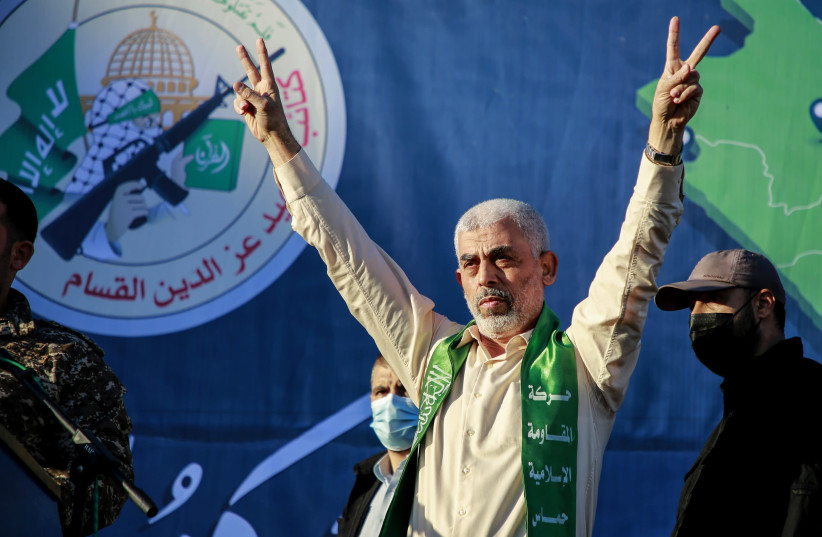The IDF on Tuesday unveiled new details regarding Hamas’s “pit” headquarters which is underground from its above-ground military high command site in Gaza City, which it took over several days ago.
While the IDF knew that the military high command area and some connected tunnel network would be hard to take, and assigned both high-powered Units 401 and Givati troops to do so, senior officials were surprised by the scope and sophistication of what could only be described as similar to the IDF’s “pit” under the Kirya military headquarters in Tel Aviv.
Part of this network included a special shaft with an elevator that did not merely go the conventional three to five meters underground that many Hamas tunnels run but rather reached an almost unheard-of depth of 30 meters.
The elevator could fit around seven people.
Inside the bottom of this special tunnel, the IDF found signs that Hamas’s high command had hidden there, with a top official speculating that this could very well have included: Gaza Hamas chief Yahya Sinwar and Hamas military chief Mohammed Deif.

This tunnel was also outfitted with oxygen, air conditioning, and even more advanced communications than other underground mini command centers.
IDF Division 162 Commander Brig. Gen. Itzik Cohen said, “we created conditions which could lead to taking apart the military and governance capabilities of Hamas in Gaza City.”
“Since the start of the invasion, the IDF and Division 162 have been taking apart the centers of gravity of Hamas and the capabilities that it spent years building. Since the start of the invasion, divisional forces have killed over 1,000 Hamas terrorists and reduced rocket fire from northern Gaza at Israel by around 80%,” he said.
Hamas's long-range missiles destroyed early
In addition, all of Hamas’s long-range Kornet anti-tank missiles were destroyed by the IDF in the invasion’s first 24 hours, though Hamas still has a large supply of shorter-range rocket-propelled-grenade launchers.
Cohen described how various IDF forces first had a goal of subduing Al-Atatra, then moved on to the command center of Hamas, then to the military quarter and its vast underground network, as well as to a naval command center, the Badr command center closer to the coast, Rantisi Hospital and its underground network, the Shaati neighborhood very close to the coast, and final Shifa Hospital and its underground command center.
Al-Atatra is a northwestern neighborhood in the city of Beit Lahiya in northern Gaza, with command center 17 being slightly further south, the military quarter being in the middle of northern Gaza, Rantisi being further south but also east, and the naval command center, the Badr command center, Shaati and Shifa Hospital being further west.
Summarizing, Cohen said that these different key points signified entering the gates of Gaza City, the center of Gaza City, and now, with the fall of Hamas in Shaati, the southern point of Gaza City.
The Shaati neighborhood alone took thousands of heavily armed IDF forces.
The naval command center also had significant weapons and intelligence hidden about 20 meters down
With Foreign Minister Eli Cohen tweeting on Monday that within two to three weeks, global pressure on Israel for a ceasefire will spike, IDF estimates are that this would be enough time to finish off remaining leftover Hamas spots in the North.
In one sign of the comprehensive toll that the IDF’s operations and the general siege of Hamas is taking on the terror group, recently 12 Hamas terrorists surrendered together near Shifa Hospital, exhausted simply by the lack of available food and water.
Also, the battalion commander of Hamas’s Shaati forces fled his battalion before the battle with IDF forces was over. IDF estimates are that cooperation with the Shin Bet will lead to successfully targeting him within a short time.
Another achievement has been that there have been zero friendly fire losses of IDF infantry from mistaken attacks by the air force.
This is a notable statistic given how aggressively the Air Force has been involved in the invasion and how dense the urban surroundings are.
One sign that there is more work for the IDF to do even in northern Gaza is that IDF forces largely circumvented fighting in the Shejaiya neighborhood, and are expected to at some point circle back there to deal with remaining Hamas forces.
This move as well as a strategy of having troops march through Palestinian houses being bulldozed by IDF D9s, as opposed to on main thoroughfares, have been key to avoiding Hamas boobytraps and ambushes which the group set anticipating the IDF to operate as it did during the 2014 Gaza conflict.
There was an eight-kilometer area leading into the center of Gaza City where Hamas had hoped to bleed the IDF so profusely that it would give up before arriving at the center.
Another key difference from 2014, is the IDF this time seeks to destroy all aspects of Hamas’s tunnel network, whereas in 2014, the IDF often sufficed with causing cave-ins in certain spots.
Hamas responded by simply digging around the cave-ins to reconnect the largely intact disparate tunnels at other spots.
While a large number of attacks on tunnels are cited, only around 30% of Hamas’s tunnels in the area have been fully destroyed to date, requiring significantly more time and investment of resources.
The IDF’s goals appear to be: first destroy Hamas forces, second destroy (not just neutralize) Hamas tunnels, and third to create pressure on Hamas to release the almost 240 Israeli hostages.
Regarding the battle over tunnels, in some cases, the IDF has collapsed tunnels with Hamas forces within them, and a later stage of destroying tunnels will need to include sifting through these areas.
Generally, the IDF has used various new capabilities, robots, and other systems to investigate tunnels, with IDF troops only entering at a later stage, and only with the approval of a high-ranking brigade commander of the rank of colonel.
